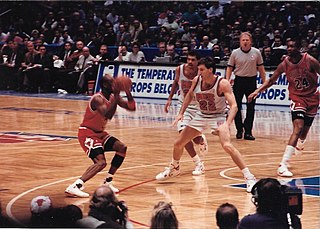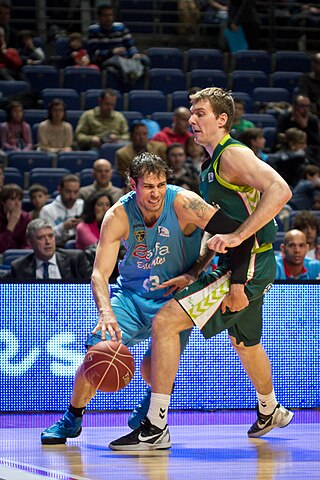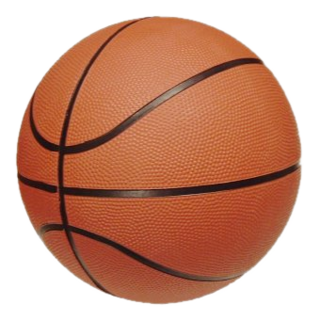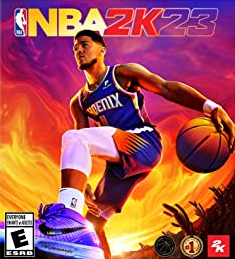
Basketball is a team sport in which two teams, most commonly of five players each, opposing one another on a rectangular court, compete with the primary objective of shooting a basketball through the defender's hoop, while preventing the opposing team from shooting through their own hoop. A field goal is worth two points, unless made from behind the three-point line, when it is worth three. After a foul, timed play stops and the player fouled or designated to shoot a technical foul is given one, two or three one-point free throws. The team with the most points at the end of the game wins, but if regulation play expires with the score tied, an additional period of play (overtime) is mandated.

In basketball, a personal foul is a breach of the rules that concerns illegal personal contact with an opponent. It is the most common type of foul in basketball. A player fouls out on reaching a limit on personal fouls for the game and is disqualified from participation in the remainder of the game.

A jump ball is a method used to begin or resume play in basketball. It is similar to a face-off in ice hockey and field lacrosse and a ball-up in Australian rules football. Two opposing players attempt to gain control of the ball after an official tosses it into the air between them.

The rules of basketball are the rules and regulations that govern the play, officiating, equipment and procedures of basketball. While many of the basic rules are uniform throughout the world, variations do exist. Most leagues or governing bodies in North America, the most important of which are the National Basketball Association and NCAA, formulate their own rules. In addition, the Technical Commission of the International Basketball Federation (FIBA) determines rules for international play; most leagues outside North America use the complete FIBA ruleset.
Basketball moves are generally individual actions used by players in basketball to pass by defenders to gain access to the basket or to get a pass to a teammate to score.
In basketball, an illegal dribble occurs when a player ends their dribble by catching or causing the ball to come to rest in one or both hands and then dribbles it again with one hand or when a player touches it before the ball hits the ground. The dribble also ends when the dribbler palms/carries the ball by allowing it to come to rest in one or both hands. This is a palming/carrying the ball violation if the player continues with another dribble.
In basketball, traveling is a violation that occurs when a player takes too many steps without dribbling the ball. Traveling is also called, predominantly in a streetball game, "walking" or "steps". If the pivot foot is lifted, the player must make an attempt at a pass or a basket, before it is placed back onto the floor.

Earl "Yogi" Strom was an American professional basketball referee for 29 years in the National Basketball Association (NBA) and for three years in the American Basketball Association (ABA). Strom is credited as one of the greatest referees in the history of the NBA and was known for his flamboyant style and ability to control the game. Nicknamed "The Pied Piper", the assertive Strom made foul calls with his whistle by using a "tweet-pause-tweet-tweet" tune and pointing at the offending player. In addition to calling fouls with flair, he was known for ejecting players from games with style and he sometimes supported his rulings with physical force.
In sports, dribbling is maneuvering a ball by one player while moving in a given direction, avoiding defenders' attempts to intercept the ball. A successful dribble will bring the ball past defenders legally and create opportunities to score.

This glossary of basketball terms is a list of definitions of terms used in the game of basketball. Like any other major sport, basketball features its own extensive vocabulary of unique words and phrases used by players, coaches, sports journalists, commentators, and fans.

A basketball is a spherical ball used in basketball games. Basketballs usually range in size from very small promotional items that are only a few inches in diameter to extra large balls nearly 2 feet (60 cm) in diameter used in training exercises. For example, a youth basketball could be 27 inches (69 cm) in circumference, while a National Collegiate Athletic Association (NCAA) men's ball would be a maximum of 30 inches (76 cm) and an NCAA women's ball would be a maximum of 29 inches (74 cm). The standard for a basketball in the National Basketball Association (NBA) is 29.5 inches (75 cm) in circumference and for the Women's National Basketball Association (WNBA), a maximum circumference of 28.5 inches (72 cm). High school and junior leagues normally use NCAA, NBA or WNBA sized balls.
In basketball, the five-second rule, or five-second violation, is a rule that helps promote continuous play. There are multiple situations where a five-second violation may occur.

In basketball, an official enforces the rules and maintains order in the game. The title of official also applies to the scorers and timekeepers, as well as other personnel that have an active task in maintaining the game. Basketball is regarded as among the most difficult sports to officiate due to the speed of play, complexity of rules, the case-specific interpretations of rules, and the instantaneous decision required.

Basketball began with its invention in 1891 in Springfield, Massachusetts, by Canadian physical education instructor James Naismith as a less injury-prone sport than football. Naismith was a 31-year-old graduate student when he created the indoor sport to keep athletes indoors during the winters. The game became established fairly quickly and grew very popular as the 20th century progressed, first in America and then in other parts of the world. After basketball became established in American colleges, the professional game followed. The American National Basketball Association (NBA), established in 1946, grew to a multibillion-dollar enterprise by the end of the century, and basketball became an integral part of American culture.

Game 6 of the 1998 NBA Finals was a professional basketball game that was played on June 14, 1998 between the visiting Chicago Bulls and the Utah Jazz at the Delta Center, in Salt Lake City, Utah. The game is widely cited as one of the most intense and iconic games in NBA history, and it is best known for Bulls superstar Michael Jordan executing a quick cross-over on Jazz forward Bryon Russell, and then hitting a jumpshot from behind the free throw line with 5.2 seconds remaining in the 4th quarter to put the Bulls up 87-86. Chicago then held on to win after John Stockton missed a 3-point field goal, winning their sixth NBA championship in eight years. Game 6 was the final game with the Bulls for Michael Jordan and coach Phil Jackson. This game earned, and still holds, the highest TV ratings of an NBA game of all time.
Basketball is a ball game and team sport in which two teams of five players try to score points by throwing or "shooting" a ball through the top of a basketball hoop while following a set of rules. Since being developed by James Naismith as a non-contact game that almost anyone can play, basketball has undergone many different rule variations, eventually evolving into the NBA-style game known today. Basketball is one of the most popular and widely viewed sports in the world.
Basketball is a team sport in which two teams of five players try to score points by throwing or "shooting" a ball through the top of a basketball hoop while following a set of rules. Basketball is one of the most popular and widely viewed sports in the world.
The Euro step, two-step, or long lateral is a basketball move in which an offensive player picks up their dribble, takes a step in one direction, and then quickly takes a second step in another direction. It is intended to allow the offensive player to evade a defender and attack the basket.
"Havlicek stole the ball" is a quote by radio broadcaster Johnny Most, as a jubilant reaction to a steal made by the Boston Celtics' John Havlicek against the Philadelphia 76ers in the 1965 NBA Eastern Division championship game seven. Most's call of the play has been dubbed by the NBA as "the most famous radio call in basketball history".

NBA 2K23 is a 2022 basketball video game developed by Visual Concepts and published by 2K, based on the National Basketball Association (NBA). It is the 24th installment in the NBA 2K franchise, the successor to NBA 2K22 and the predecessor to NBA 2K24. The game was released on September 9, 2022 for Microsoft Windows, Nintendo Switch, PlayStation 4, PlayStation 5, Xbox One and Xbox Series X/S. The NBA 2K23 Arcade Edition was released on Apple Arcade on October 18, 2022.













